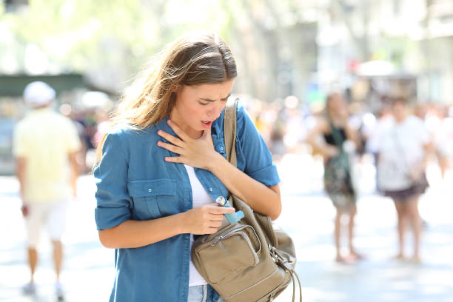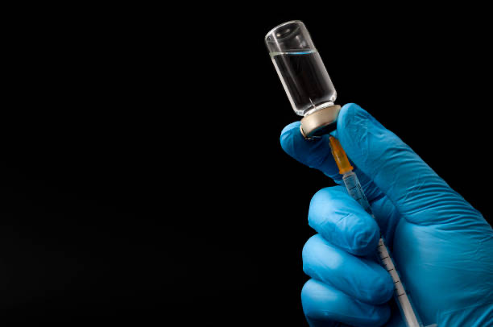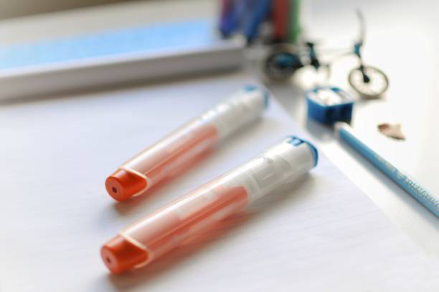Epinephrine (Adrenaline)
Uses, Benefits and Side Effects of Epinephrine (Adrenaline)
Epinephrine (Adrenaline) Overview
Have you ever been to a party, and one of your friends starts wheezing, coughing, and experiencing difficulty in breathing only because he ate a peanut desert? Then you might be familiar an EpiPen. It is used to reduce the symptoms of all seasonal allergies, including food allergy, dust allergy, fur/pet allergy, and many more.
But have you ever wondered how Epinephrine works in reducing your allergy attack? Why is it a must-have for people with seasonal allergies? Then you in the right place. In this article, we will discuss adrenaline and how it works.

Epinephrine
Epinephrine is also known as adrenaline, and is a hormone that is produced by our body to prepare ourselves in fight or flight situation. Normally, when we’re scared, anxious, or nervous, adrenaline is produced. This speeds up our heartbeat and makes us sweaty. But in an allergic attack, adrenaline can save lives.
How Does It Work?
In an allergic attack, Epinephrine is either injected or inhaled in the body. This quickly speeds up the heartbeat allowing blood to flow into restricted airway muscles, which helps it to loose up and open up the airways. This enables the person to breathe again and help normalize the situation.
It does this by binding with alpha and beta receptors. It has also shown that Epinephrine provides a boost in confidence, but still requires further research.
Benefits of Epinephrine
Epinephrine is not only restricted to allergies and seasonal allergies. It has many other benefits as well; these include:
- Given to a patient with cardiac problems
- Given to a patient in cardiac arrest
- Used in the treatment of asthma
- Used to cure many infections such as Croup
- It is used in conjunction with anesthesia to prolong its effect
Epinephrine is used to treat many diseases, but mainly seasonal allergies and plays an important part in medical society.
Side Effects
With every miracle drug, there are some hidden side effects that you should know in order to plan every step of the treatment. Epinephrine has minor adverse effects.
Following are the side effects of Epinephrine:
- skin redness, swelling, warmth, or tenderness at the site of injection
- difficulty breathing
- pounding, fast, or irregular heartbeat
- nausea
- vomiting
- sweating
- dizziness
- nervousness, anxiety, or restlessness
- weakness
- pale skin
- headache
- involuntary shaking of a body part
These start pretty standard but can escalate to something severe, so run to the ER if any signs are popping up.

Normal Dosage of Epinephrine
Very low dosages of Epinephrine is generally required, for an adult, the average dosage is 0.3mg/0.3mL for an EpiPen and 0.1 – 1.0 mg for injectable solutions.
0.3 – 0.5 mg undiluted Epinephrine is administered into the bloodstream during an extreme seasonal allergy attack. 0.3 mg is inserted with an EpiPen.
This dosage varies from person to person. The dosage for a child is different as well, so you should consult a doctor to know your precise dosage.
Overdosage
Overdosage of Epinephrine from an EpiPen is uncommon and rarely happens because it contains an average amount that is suitable for everybody. But through an injection, it is quite common. A difference of two to three mg can cause the following symptoms:
- sudden weakness or numbness on one side of the body
- sudden difficulty speaking
- slow or fast heart rate
- shortness of breath
- Rapid respiration
- Confusion and uncertainty
- tiredness or weakness
- cold, pale skin
- decreased urination
Overdosage of Epinephrine can cause stroke, heart attack, hemorrhage, or cardiac arrest/arrhythmia. The human epinephrine minimum lethal dose was estimated to be 4 mg per subcutaneous injection. However, a maximized dose of Epinephrine injected subcutaneously was expected to be 7 to 8 mg with proper treatment.
Treatment for Overdose
Labetalol is the only treatment for Epinephrine overdose. It reverses the harmful effect of the treatment, but the positive results remain as it is. This drug is life-saving for many people who suffered from Epinephrine overdosage.
Storage and Disposal of Epinephrine
Keep your EpiPen in a plastic carrying bag, tightly closed, out of the reach of children. It should never be put in a fridge or on a kitchen shelf. It should remain at room temperature, and you should carry it around you with either in your purse or your pocket.

Disposal
If there is a leak in your EpiPen or it is exposed for too long in a hot or cold environment (Many EpiPen’s have color changing strips telling you either it’s too hot or too cold), then its time to throw it.
You should not throw it in a dustbin or flush it in the toilet. Contact your pharmacist and ask them what your approach should be; the best method is to sign up for the take-back program. Whatever you do, do not throw it in the dustbin.
Conclusion
Epinephrine is a must-have drug to cure seasonal allergies as well as during emergencies. It is used in almost every emergency to calm down the situation. It is a very effective drug that cures the problem within seconds.
Written by: Madiha Ather Hashmi (May 19, 2020)
Sources
- Medline Plus (2018). “Epinephrine Injection”. AHFS® Patient Medication Information.
https://medlineplus.gov/druginfo/meds/a603002.html - Wikipedia (2021). “Adrenaline”. Creative Commons Attribution-ShareAlike License.
https://en.wikipedia.org/wiki/Adrenaline - April Cashin-Garbutt, MA (2019). “What is Epinephrine (Adrenaline)?”. News-Medical.Net.
https://www.news-medical.net/health/What-is-Epinephrine-(Adrenaline).aspx - Rachel Nall, MSN, CRNA (2018). “What’s the Difference Between Epinephrine and Norepinephrine?”. Healthline Media.
https://www.healthline.com/health/epinephrine-vs-norepinephrine#uses
Medically Reviewed By

Alexandria University Hospital
I have reviewed the articles on seasonalallergies.org and I would like to say that I was very surprised.
Over years, I have seen many different articles in the field of allergy, but these articles were very interesting.
These articles were really unique, they could help many people around the world to know more about seasonal allergy, symptoms, prevention and when to seek medical advice.
These articles represent an addition in the field of Health Education not only for people with allergy but also for the whole population.
Looking for more treatment options? Find a full list of other seasonal allergy treatment options here.
Last Updated on July 5, 2023